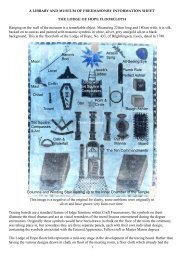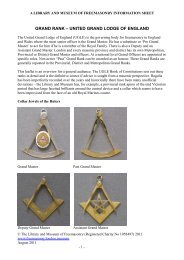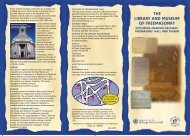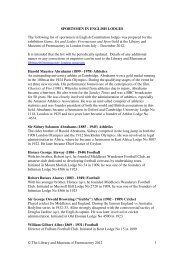The Royal Masonic Hospital and Its Jewels - The Library and ...
The Royal Masonic Hospital and Its Jewels - The Library and ...
The Royal Masonic Hospital and Its Jewels - The Library and ...
Create successful ePaper yourself
Turn your PDF publications into a flip-book with our unique Google optimized e-Paper software.
A LIBRARY AND MUSEUM OF FREEMASONRY INFORMATION LEAFLET<br />
THE ROYAL MASONIC HOSPITAL AND ITS JEWELS<br />
In 1911, members of Malmesbury Lodge No. 3156 became interested in the possibility of starting a<br />
<strong>Masonic</strong> hospital or nursing home <strong>and</strong> formed a committee with a civil engineer, Percy Still, as<br />
secretary. In 1913 Gr<strong>and</strong> Lodge approved the idea <strong>and</strong> by 1916 fundraising had begun. <strong>The</strong> spiralling<br />
number of Great War casualties moved supporters of the hospital scheme to take out a short term lease<br />
of the former Chelsea Woman’s <strong>Hospital</strong> in Fulham Road, London <strong>and</strong> open it as the Freemasons’ War<br />
<strong>Hospital</strong>. Over 4,000 servicemen were treated at the hospital by the end of the war. Additional facilities<br />
were opened at Fulham Palace <strong>and</strong> a convalescent home was opened in Caversham near Reading<br />
After World War I the Freemason’s <strong>Hospital</strong> <strong>and</strong> Nursing Home opened in the Fulham Road premises<br />
<strong>and</strong> accepted its first patient in 1920. Despite alterations this site proved too small <strong>and</strong> supporters<br />
continues their efforts to find a larger site. Once sufficient funds were secured a site was purchased at<br />
Ravenscourt Park, West London. In 1933, King George V <strong>and</strong> Queen Mary opened the hospital <strong>and</strong><br />
the King granted permission for it to be known as the <strong>Royal</strong> <strong>Masonic</strong> <strong>Hospital</strong>. Money for the hospital<br />
was raised through donations, with donors being awarded a special jewel, known as the Permanent<br />
Steward’s Jewel.<br />
During the Second World War the hospital again became a war hospital, treating over 8,600<br />
servicemen, at no cost to the government. After the war, the formation of the National Health Service<br />
saw the end of many private hospitals but the <strong>Royal</strong> <strong>Masonic</strong> <strong>Hospital</strong> remained independent. A School<br />
of Nursing was established in 1948 <strong>and</strong> it quickly gained a reputation for producing highly skilled<br />
nurses, whose distinctive silver belt buckles became a coveted honour amongst the profession.<br />
<strong>Royal</strong> <strong>Masonic</strong> <strong>Hospital</strong> Nurses’ Uniform Buckle<br />
By the late 1970s approximately 4,700 patients per year were being treated. Although patients were<br />
mostly freemasons, fee paying non-members were accepted from 1977. In 1976 the Gr<strong>and</strong> Master, the<br />
Duke of Kent, opened the Percy Still wing, with four new operating theatres. However, fewer masons<br />
wanted to travel to London for treatment <strong>and</strong> running costs grew rapidly due to inflation. In 1992<br />
Gr<strong>and</strong> Lodge recommended that it’s closure to safeguard its assets. In 2002, the hospital buildings were<br />
acquired by the Hammersmith <strong>Hospital</strong>s NHS Trust as Ravenscourt Park <strong>Hospital</strong>, to relieve bed<br />
shortages.
Numerous jewels were produced in association with the <strong>Royal</strong> <strong>Masonic</strong> <strong>Hospital</strong>, the most commonly<br />
encountered being the Permanent Steward’s Jewel <strong>and</strong> the Redevelopment Fund Jewel.<br />
From left to right-<br />
Permanent Steward’s Jewel – It was designed by C.L.J. Doman (who also produced the Armistice<br />
Anniversary medal in 1928). <strong>Its</strong> ribbon is in the dark <strong>and</strong> light blue of Craft masonry <strong>and</strong> the design<br />
shows humanity succouring the sick. <strong>The</strong> motto, ‘Aegros Sanat Humanitas” means ‘Kindness Heals the<br />
Sick’. <strong>The</strong> five pointed <strong>Masonic</strong> star <strong>and</strong> the interlaced letters ‘FH’ (Freemasons <strong>Hospital</strong>) complete the<br />
design. <strong>The</strong> Jewel was first issued in silver, engraved on the reverse with the donor’s name <strong>and</strong> lodge<br />
number, but later was plain <strong>and</strong> in base metal. Depending on the donation the jewel sometimes had a<br />
bar marked ‘VICE-PATRON’, ‘PATRON’, ‘GRAND VICE-PATRON’ <strong>and</strong> ‘GRAND PATRON’.<br />
Redevelopment Fund Jewel – This jewel was issued to those who subscribed £12 or more to the<br />
Assistant Gr<strong>and</strong> Master’s Redevelopment Fund to build the 1956 extension to the hospital. Those who<br />
already had the hospital jewel were given a bar to wear with it rather than this jewel. <strong>The</strong> jewel was the<br />
concept of Leslie Durbin, M.V.O. LL.D., artist <strong>and</strong> silversmith. It shows a detail of a h<strong>and</strong> from a<br />
painting by the artist Botticelli. Earlier versions had wording on the reverse but this was later omitted.<br />
Jewel for ladies who became Life Governors in 1932, at the hospital’s opening, incorporating the image<br />
from the Permanent Steward’s Jewel. <strong>The</strong> bar monogram is ‘FH’ for ‘Freemason’s <strong>Hospital</strong>’ as the<br />
building had not yet been granted its royal title. <strong>The</strong> jewel is made from multiple parts <strong>and</strong> is 9ct gold.<br />
Jewel for lady patrons after the opening of the hospital. Generally similar to the above, but this is a<br />
single casting in silver gilt <strong>and</strong> enamel, with the monogram changed to ‘RMH’, for ‘<strong>Royal</strong> <strong>Masonic</strong><br />
<strong>Hospital</strong>’. Other versions of this jewel <strong>and</strong> the one described above exist with slight variations.<br />
Nurses’ issue jewel with an enamelled bar rather than a ribbon to make it suitable for wear with a<br />
uniform, incorporating the image from the Permanent Steward’s jewel.<br />
© <strong>The</strong> <strong>Library</strong> <strong>and</strong> Museum of Freemasonry (Registered Charity No 1058497) 2010<br />
www.freemasonry.london.museum<br />
December 2010










